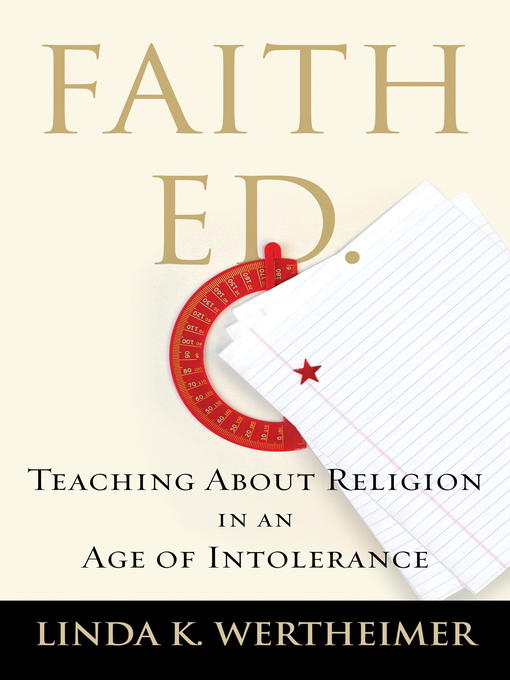
Faith Ed
Teaching About Religion in an Age of Intolerance
کتاب های مرتبط
- اطلاعات
- نقد و بررسی
- دیدگاه کاربران
نقد و بررسی

July 6, 2015
Former Boston Globe education editor and former Dallas Morning News reporter Wertheimer is shocked when swastikas are painted in the boy’s bathroom at a suburban Boston high school near her home. The March 2014 incident forces Wertheimer to recall similar events more than 40 years earlier, when she and her brothers were the only Jewish students in a rural Ohio public school. With skill and intelligence, the veteran interviewer crisscrosses the country in search of a public school program that teaches religious literacy well. What she finds are sincere instructors with little training in how to teach about religions as an academic subject. Despite more than 70 years of effort and several Supreme Court rulings, Wertheimer writes, “There has never been a nationwide movement to make the world’s religions a more integral part of education.” However, religion and public education do not have to be at odds. In this thorough investigation, Wertheimer makes a strong case for developing a public school pedagogy to promote rights, responsibilities, and respect for the richly woven religious fabric found in the United States.

May 1, 2015
Narrow examination of the teaching of religion in America's public schools. Education writer Wertheimer experienced anti-Semitism firsthand on various occasions while growing up in Van Buren, Ohio, in the 1970s. The experience shaped her and thoroughly shapes this book on the teaching of world religions in public schools. Justified or not, the author's study comes across as pre-concluded and defined by a restrictive set of values and views. Wertheimer traveled to a handful of places where the teaching of religion has in one way or another been newsworthy, and she interviewed local students, teachers, administrators, and community leaders. In Lumberton, Texas, she explored a controversy that arose when students tried on burkas during a class discussion about Islam. In Wichita, Kansas, she visited an elementary school that has experimented with beginning world religion education as early as first grade, with mixed reception by the public. In Modesto, California, she toured a school system that intentionally built a religion curriculum based on extensive training and strict adherence to "equal time." The author's case studies are interesting and well-documented but hardly broad enough to provide a picture of the education of religion nationwide. Moreover, no matter how much readers may want to agree, Wertheimer's personal prejudices are simply too heavy to ignore. Evangelical Christianity is always immediately suspect in her writing, while other faiths are not. For instance, she sees it as a success when the religion class in Modesto caused a Pentecostal girl to question her faith, stop wearing long skirts, and in the end leave her church tradition. It is difficult to imagine the author being equally happy about a woman of any other faith tradition having the same reaction. Wertheimer also looks down on rural or noncoastal America with a stereotypical haughtiness, and the book is replete with references to her experience growing up, which, though perhaps valid, don't add much to the narrative. A worthwhile study marred by bias.
COPYRIGHT(2015) Kirkus Reviews, ALL RIGHTS RESERVED.

June 15, 2015
Journalist Wertheimer tackles the problem of discussing world religions while also trying not to make it a contentious issue within a public school context. She wonders how schools can ensure that the next generation will not experience religious intolerance. The book collects interviews with individuals who have experienced some level of intolerance as a result of their religion or because of teaching about religion. The reader connects to each story shared, but Wertheimer's initial questions lack direct answers. It feels as though the book needed one more chapter to offer practical guidance for teachers and administrators. Perhaps that was intentional, as it does cause one to stop and reflect on what a beneficial model for engaging religious tolerance positively in the educational realm would or should look like. VERDICT This book sheds light on the reality that people hide their religious background in a school environment at times out of fear. It may be of value for individuals who have experienced religious intolerance at school or for those linked to public schools by raising awareness for religious groups that may not yet have a voice.--Mark Hanson, Maranatha Baptist Univ. Lib., Watertown, WI
Copyright 2015 Library Journal, LLC Used with permission.

June 1, 2015
Wertheimer visited a handful of small and medium-sized public school systems that experienced controversy over teaching about the world's religions in geography or world-history classes. In Lumberton, Texas, trouble ensued when a photo of a student trying on a burka was posted on Facebook. The Wellesley, Massachusetts, system drew flack over taking sixth-graders on a field trip to a mosque. Having a Muslim talk about Islam to high-schoolers in a Tampa, Florida, suburb put its high school in the crosshairs of a notorious political blogger. Wertheimer also revisited her youth in which she, a Jew, had felt uncomfortable when the church lady led her class in Christian prayer and songs. Talking with those involved in the controversies (teachers, parents, administrators, activists) as well as students in the classes under fire, she found no monsters of intolerance but instead dedicated and careful educators, short-fused yet not unreasonable opponents of teaching about religion, and plenty of kids glad to have been taught. A report less contentious than its subtitle seemingly implies.(Reprinted with permission of Booklist, copyright 2015, American Library Association.)

























دیدگاه کاربران